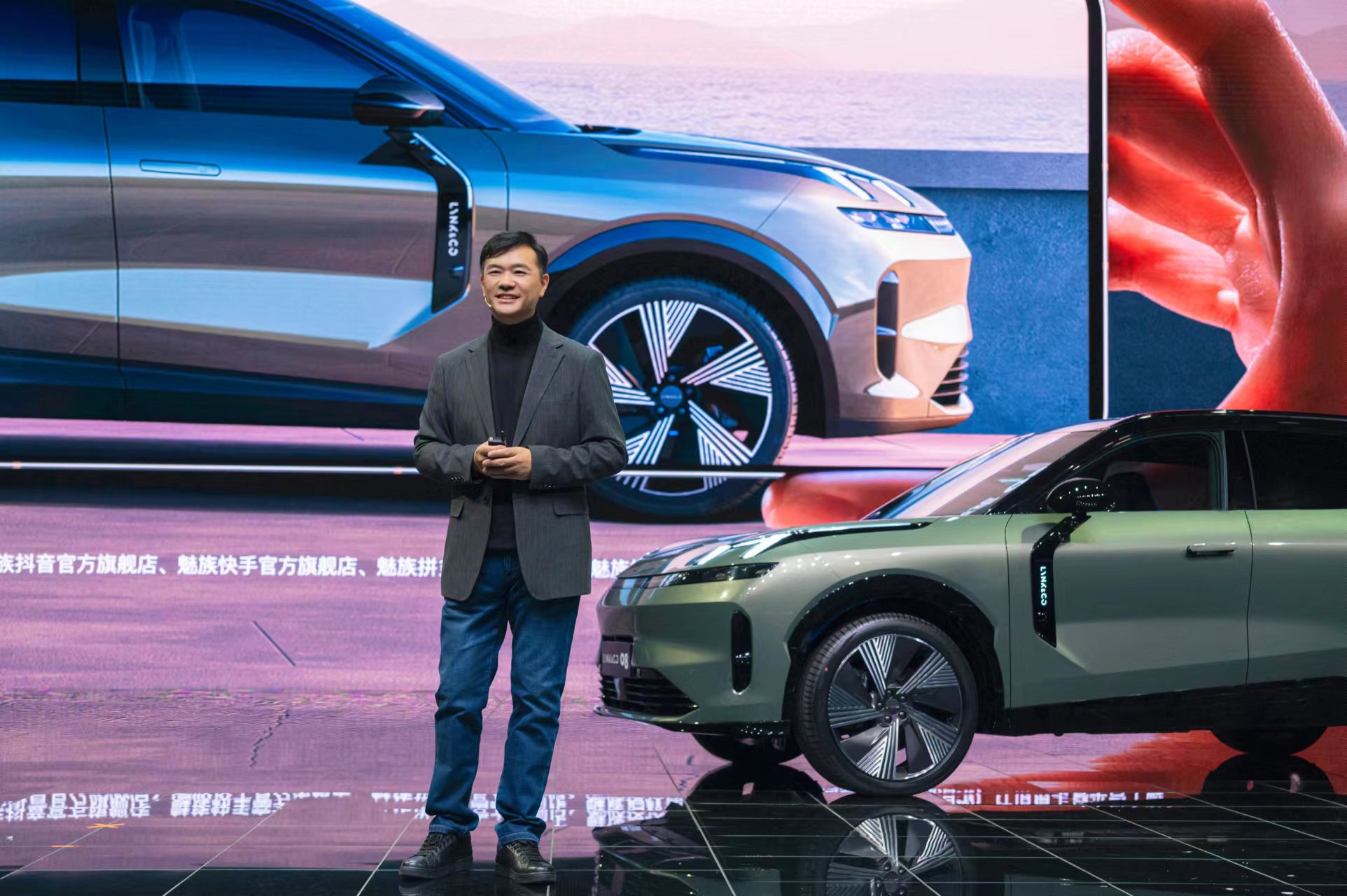Translate the following Chinese Markdown text into English Markdown text, maintaining the professional tone and retaining the HTML tags in Markdown. Only output the result.
Prior to this press conference, I asked a question to the digital enthusiasts in the office who were also former Meizu smartphone users:
“What attracts you most about Meizu?”
Everyone’s immediate response was “attractive design and high aesthetic standards.”
In the years of rampant growth in the mobile phone industry, Meizu won over many young consumers with its sleek and elegant Flyme. The fact that people referred to Meizu as “small yet beautiful” just demonstrated how much everyone appreciated it then. When talking with fellow “Meizu friends,” there was often a sense of shared empathy.
Back then, no one might have expected that the “small yet beautiful” Meizu would eventually “go big,” with Flyme transforming into Flyme Auto.
As the first product in LYNK & CO’s comprehensive electric-mixed lineup, we had previously discovered during our experience that the LYNK & CO 08 is a product that is very “caring” in both exterior and interior details. The much-anticipated Flyme Auto is also about to make its debut on the LYNK & CO 08.
And here comes the question: What kind of spark can the collision of these two bring to the LYNK & CO 08’s cockpit?
Cabin Atmosphere: Is there a new way to enjoy it?
“Ambiance” refers to a specific atmosphere or feeling, usually produced by a combination of elements such as space, light, sound, texture, and interaction.
In a car’s cabin, simply relying on “outstanding intelligence” is not enough to provide this sensation. Flyme Auto and LYNK & CO 08’s cabin design redefine “ambiance” together, pioneering an integrated approach to interior lighting, central control screen, and sound.
First, let’s take a look at what the LYNK & CO 08 with Flyme Auto has done in terms of ambiance. For example, in the three modules of “Nap Mode,” “Time Engine,” and “Natural Experience,” Flyme Auto incorporates more dynamic effects and scene-changing effects on top of its design sense, allowing the vehicle system to blend into the entire cabin environment of the LYNK & CO 08, resulting in a more immersive experience.
In the “Time Engine,” as the daylight changes throughout the day, the background will change accordingly, and the LYNK & CO 08’s rendered car model will also change with the shifting light and shadows.
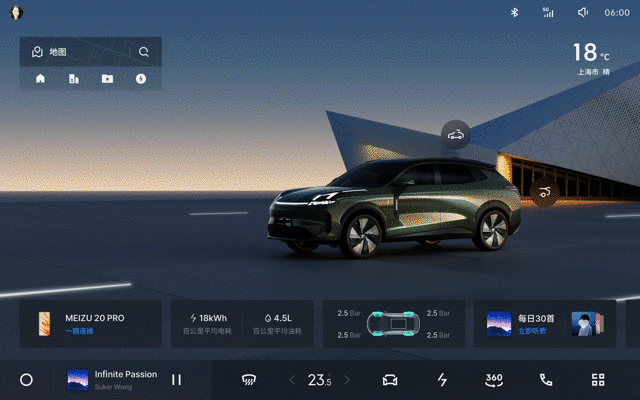 Under the “Suchness Engine”, the dynamic effect changes accordingly with the air conditioning temperature.
Under the “Suchness Engine”, the dynamic effect changes accordingly with the air conditioning temperature.
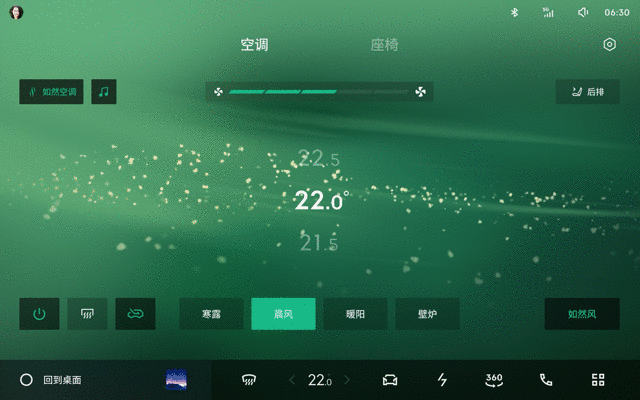
Interestingly, there is the “Nap Mode”. In this mode, the fireflies on the car screen interact with the ambient light, fading in and out. To achieve this effect, the Lynk & Co 08 must interact with its interior ambient lighting, sound system, and screen, which is a testament to the deep collaboration between the two companies.
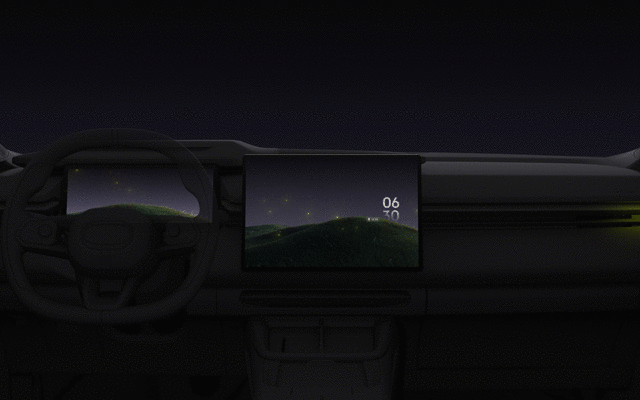
I struggled to find an appropriate adjective to describe the magical experience of connecting all independent components within the vehicle. Ultimately, “Alive Design” seems to be the most fitting.
Regarding the cockpit itself, many design aspects of the Lynk & Co 08 were considered from the outset to create this “atmosphere”. For instance, Lynk & Co and Harman Kardon signed a collaboration during the early stages of the car’s development, resulting in 23 speakers with a maximum output of 1,600 watts. Their design seamlessly integrates with the overall cabin ambiance, including subtle lighting beneath the cover that, along with the sound, delivers breathing, color-changing, and pulsating effects.
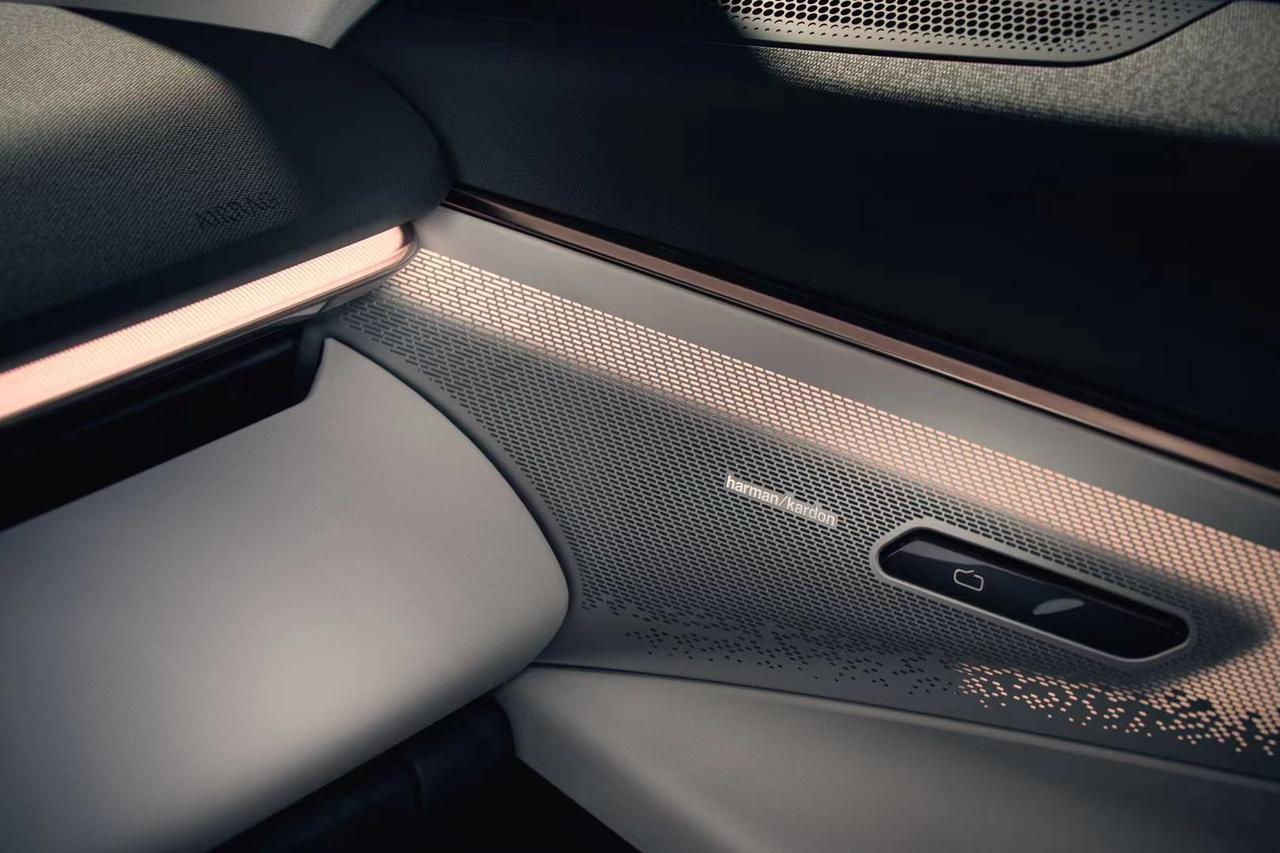
The 92-inch AR-HUD has a 2K resolution, supporting AR navigation and ADAS driving assistance information. Traditional HUD modules require cutting holes in the dashboard, compromising aesthetics. On the Lynk & Co 08, the AR-HUD and front speaker are designed as a “floating island,” resembling a futuristic device artwork that doesn’t disrupt the overall ambiance.
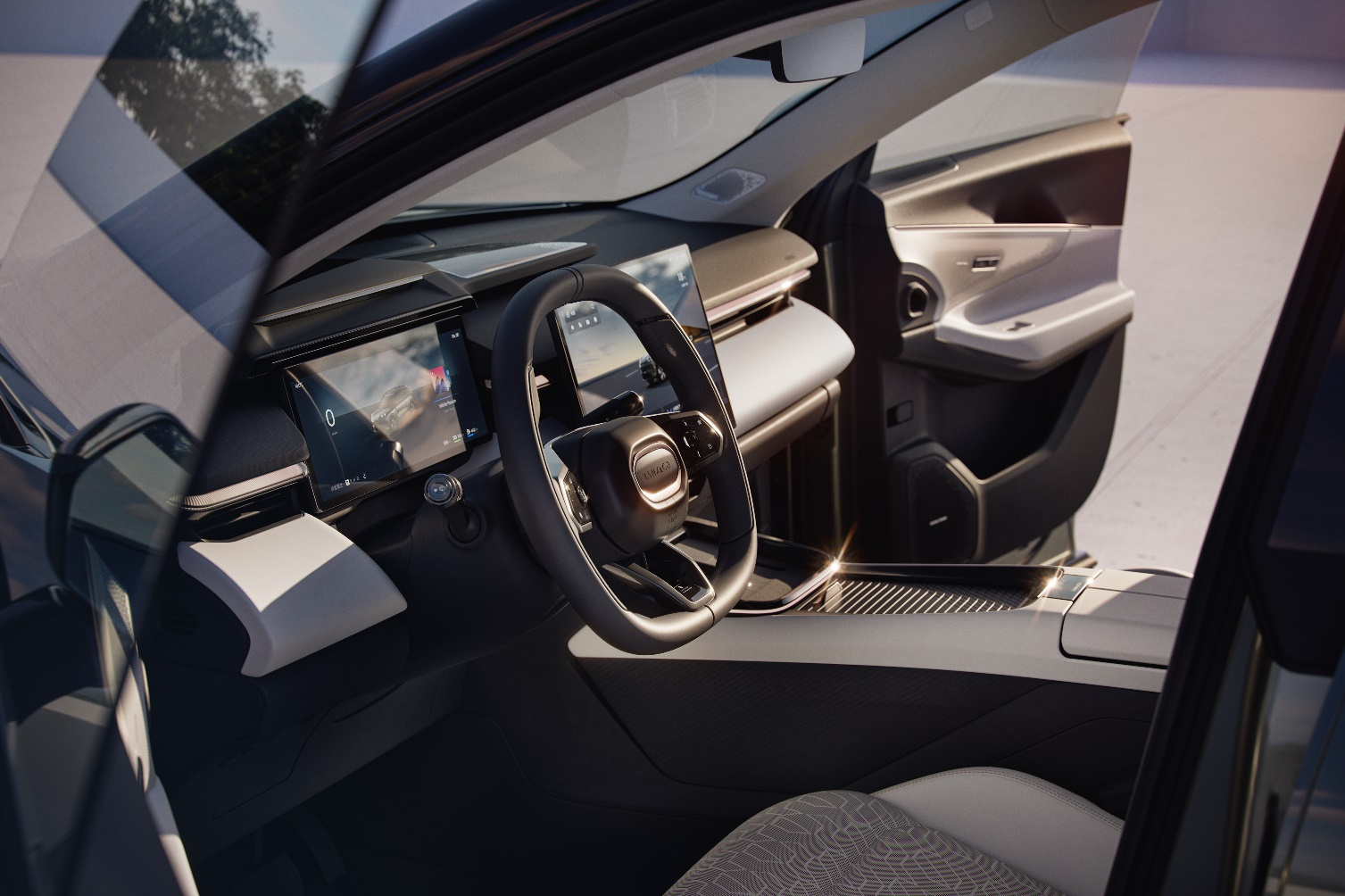 Translate the following Markdown Chinese text into English Markdown, keeping the HTML tags within the Markdown format and only outputting the result:
Translate the following Markdown Chinese text into English Markdown, keeping the HTML tags within the Markdown format and only outputting the result:
This is also the annotation of “boundaryless” in this press conference:
Not only is it the “boundaryless” cooperation between Meizu and Lynk & Co, but also the “boundaryless” combination of individual elements in the cabin.
Famous designer Dieter Rams once said that good design should be minimal, functional, and aesthetically pleasing, while being harmoniously integrated with the environment. Designers should achieve better design effects by simplifying design and reducing unnecessary elements, that is, “good design is environmental design.”
So if we want to summarize the interior design of Lynk & Co 08, “integration of technology and design” might be the best annotation. There are no flamboyant design elements clamoring to attract attention, nor superfluous ones to make the design heavy. Under the embellishment of space, light, sound, material, and interaction, the “ambience” has become the optimal annotation for Lynk & Co 08’s cabin.
And the foundation of all this is the Antora 1000 Pro computing platform by Yicar. Among them, 2 “Lung Ying No.1” chips have an NPU computing power of 16 TOPS and a GPU computing power of up to 1800 G (FLOPS).
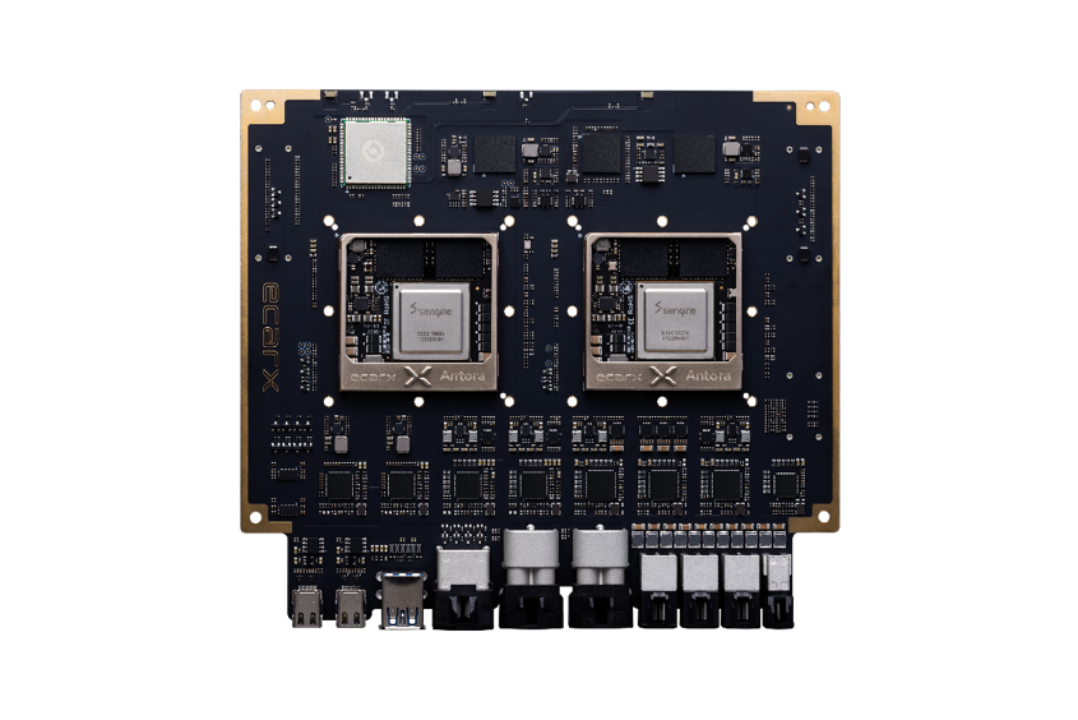
This is also the reason why Lynk & Co 08 dared to be so bold in dynamic effects and model rendering: with computing power, you can do whatever you want.
Lynk & Co 08, in-vehicle infotainment leading the pack?
“How does the Lynk & Co 08’s in-vehicle infotainment perform without a smartphone?”
This might be the question most people care about the most.
Having watched the press conference, I can responsibly say: With the help of Meizu’s decade-long accumulation in the mobile phone field, the Lynk & Co 08’s in-vehicle infotainment system, equipped with Flyme Auto, has achieved industry-leading results in information distribution, interaction logic, UI/motion design, and spatial experience.

This might also be the confidence behind Meizu’s slogan “no smartphone, still a dimensionality reduction attack” displayed at the press conference venue.Exploring “Human-Machine Interaction,” “UI/Animation Design,” and “Scenery/Ambiance” aspects, we delve into where the “Alive Design” concept of the Lynk & Co 08’s cabin design with Flyme Auto is headed.
Human-Machine Interaction: Highly customizable spaces
The Lynk & Co 08’s infotainment system main interface supports switching between wallpaper mode, garage mode, and map mode display effects. For aesthetics, choose wallpaper mode; for a technological feel, select the highly detailed garage mode; for route information, opt for map mode. Compared to the bland design of a map constantly dominating the main interface, there’s much more room for personalization and choice.
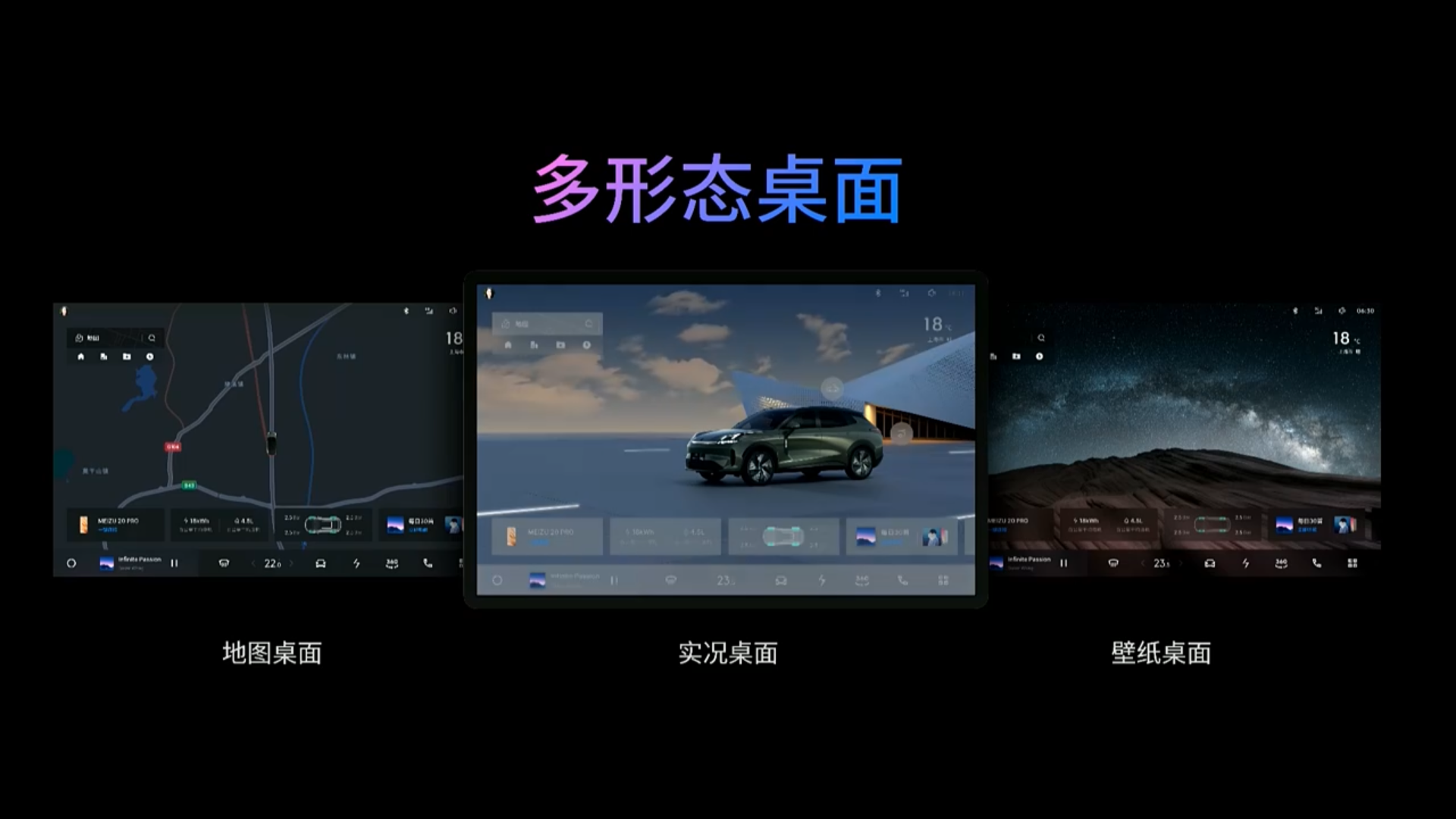
Beyond that, the interface’s cards, Dock bar, and Smart Bar all offer high degrees of customizability. For example, arrange energy consumption, tire pressure, music, seats, and other information according to your usage habits in any of the four positions above the Dock bar.
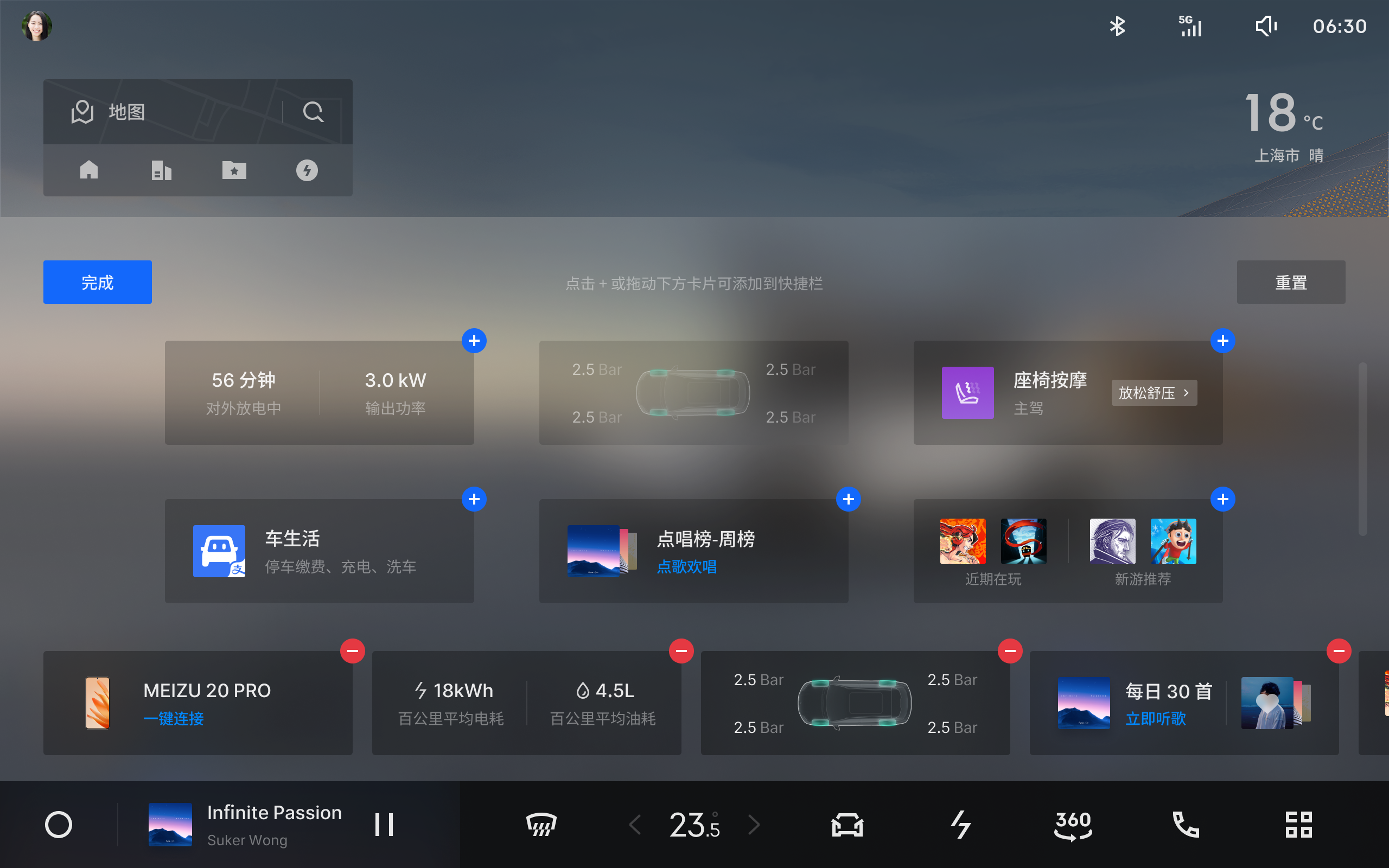
You can even customize the Dock bar on the Lynk & Co 08. According to your preferences, arrange higher-frequency function entrances from left to right. Meizu clearly understands the importance of “personalization” in cabin design, offering various customizable combinations so everyone can find the arrangement that best suits them.
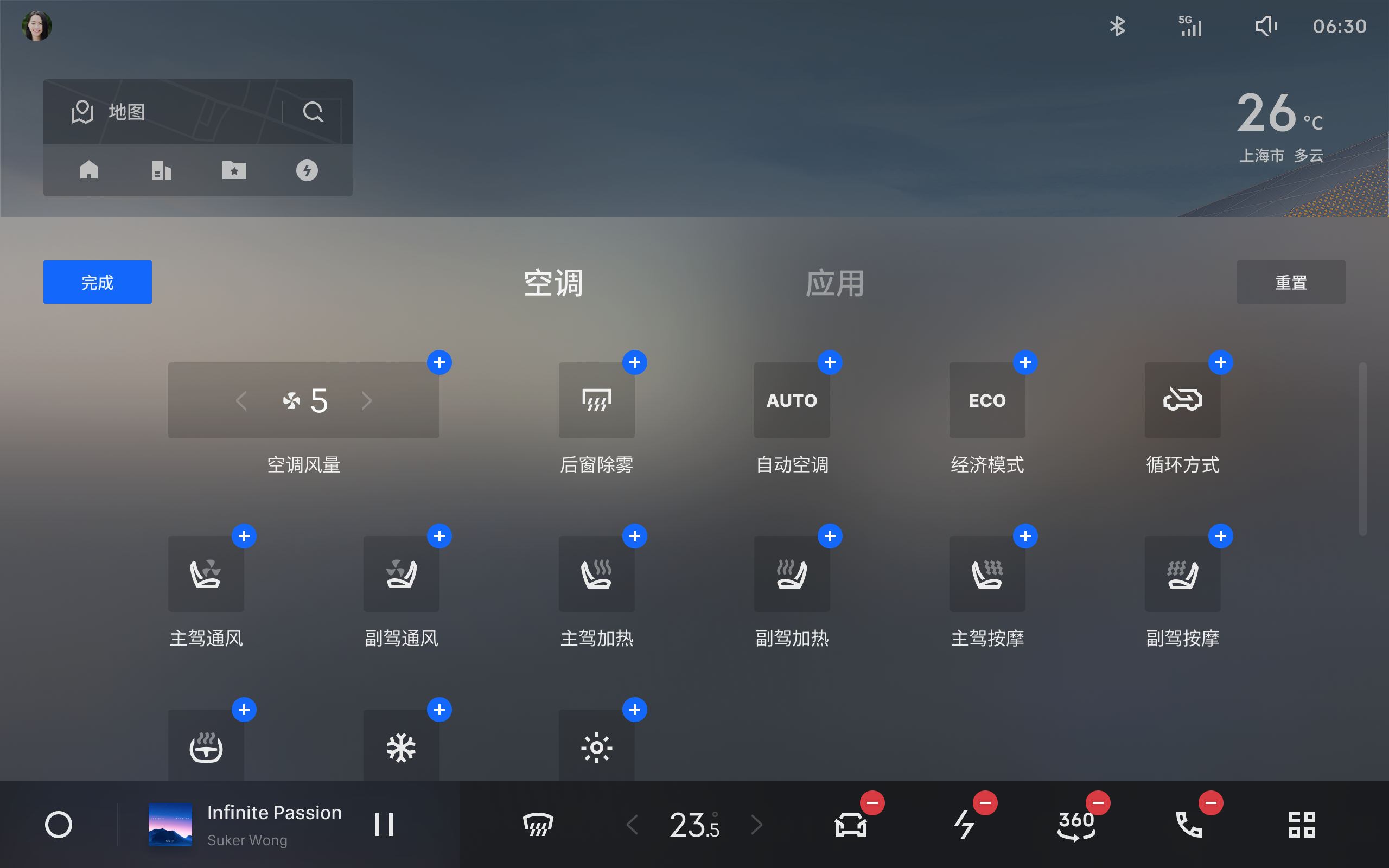
The Smart Bar is another Lynk & Co 08 innovation in the infotainment system. In the relatively fixed Dock bar, the Smart Bar is like the agile island on the iPhone 14 Pro, allowing seamless switching between charging, navigation, music, and other information, providing a display and interaction window for background data.
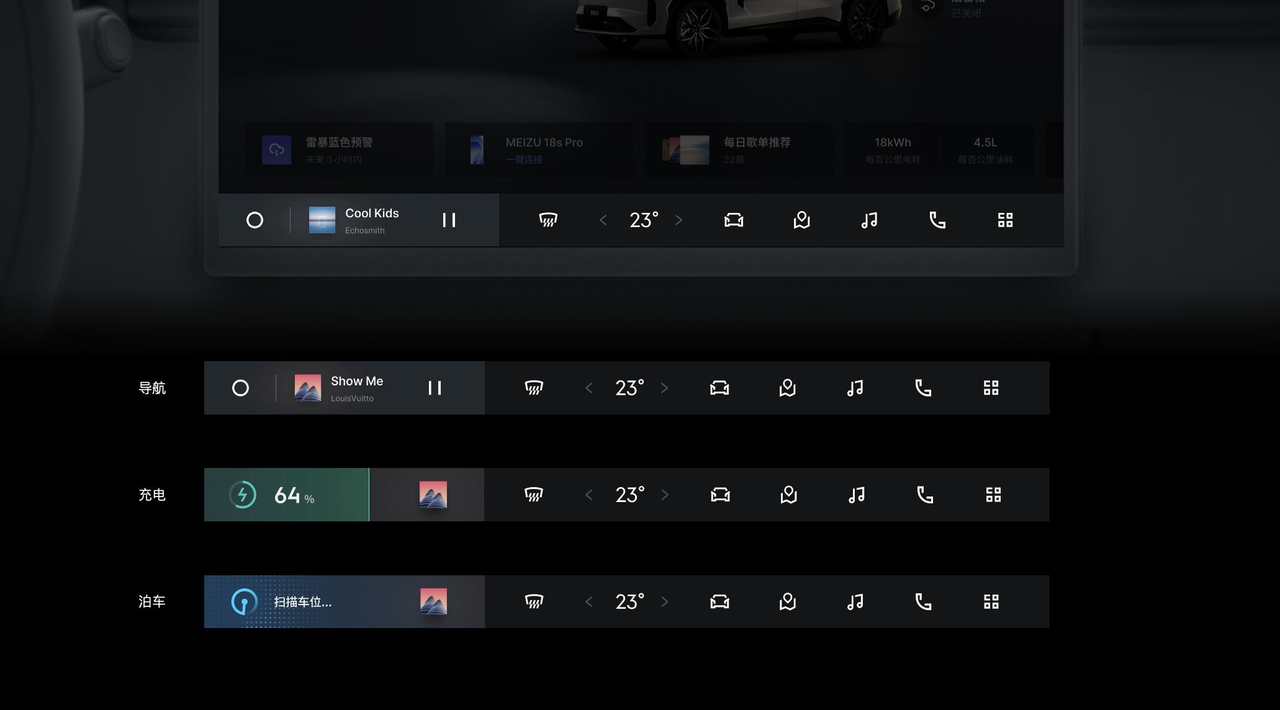 The interaction of the Lynk & Co 08 adheres to the “flat” principle. From the “Settings” menu, one can access the function operation interface with a single tap, with vehicle control, lighting, driving, and assisted driving information arranged in descending order of priority.
The interaction of the Lynk & Co 08 adheres to the “flat” principle. From the “Settings” menu, one can access the function operation interface with a single tap, with vehicle control, lighting, driving, and assisted driving information arranged in descending order of priority.
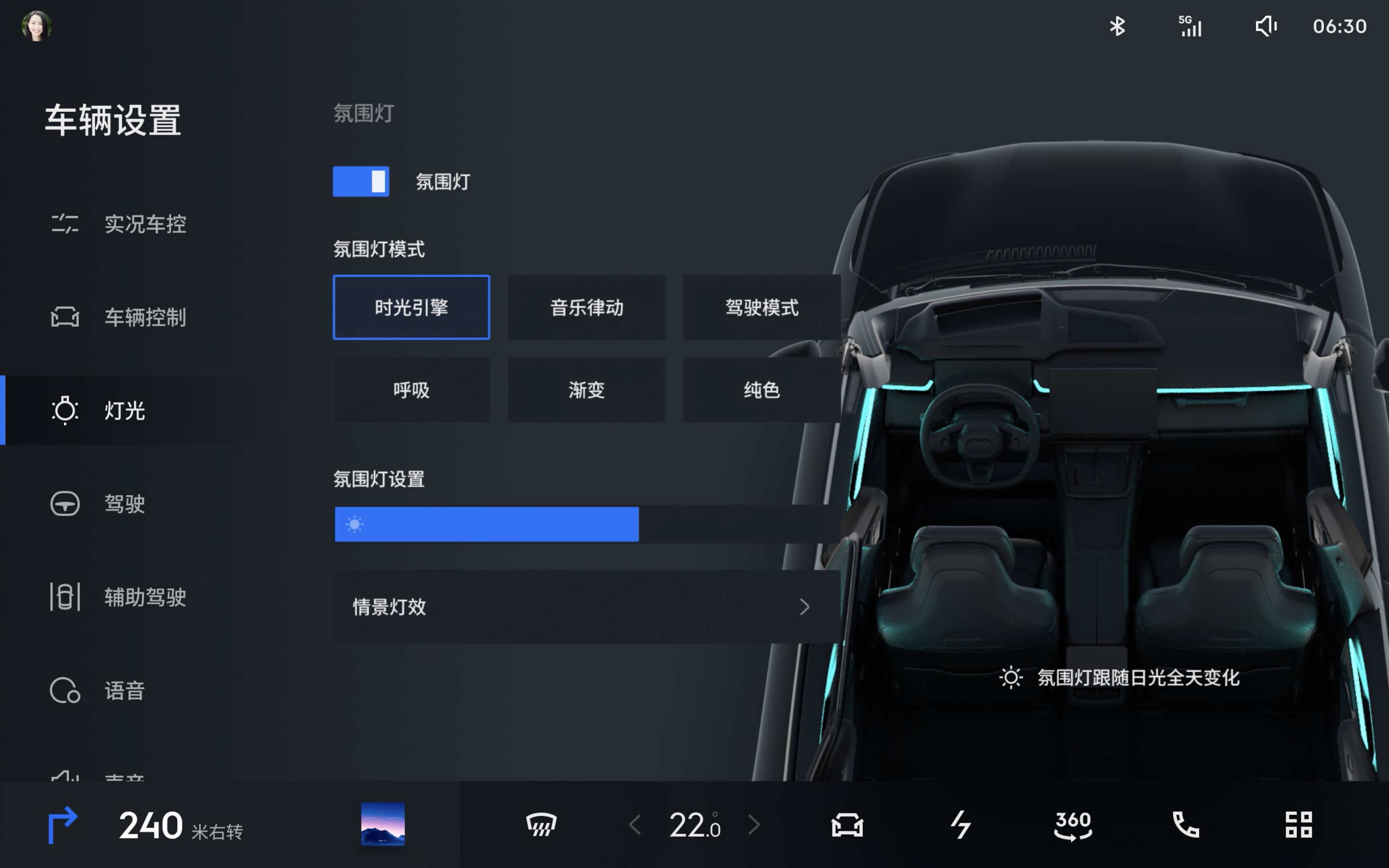
However, whether the division of functions within each area is reasonable and whether “Live Vehicle Control” aggregates frequently used functions will be the focus of future experience.
Finally, the interaction logic of the Lynk & Co 08 equipped with Flyme Auto remains consistent with mobile phones: swipe left to return, swipe down to enter the negative one screen, and pinch to return to the home screen. The adaptation cost from mobile phones and tablets to car consoles will be significantly reduced.
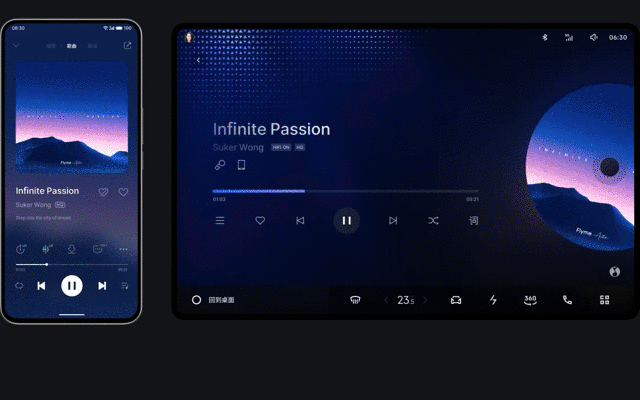
Mobile phone manufacturers’ experience in interaction logic has indeed created a “dimensional reduction” advantage when applied to car consoles.
UI and Motion: Agile and Smooth
The Flyme Auto UI details, color schemes, and backgrounds on the Lynk & Co 08 are all custom, making every detail we see agile, concise, and designed with a sense of style.
What’s even more impressive is that Meizu, the “detail fanatic,” has also designed “micro-motion effects” for the Lynk & Co 08’s UI. Volume, vehicle, and other menu icons use subtle changes to provide feedback to operators.

From the small icons to the weather and detailed car models rendered in the background, to the stylistic and font consistency in various menu icons. Now, do you understand the true essence of “Alive Design”?
In terms of motion effects, the Lynk & Co 08 equipped with Flyme Auto is unparalleled.
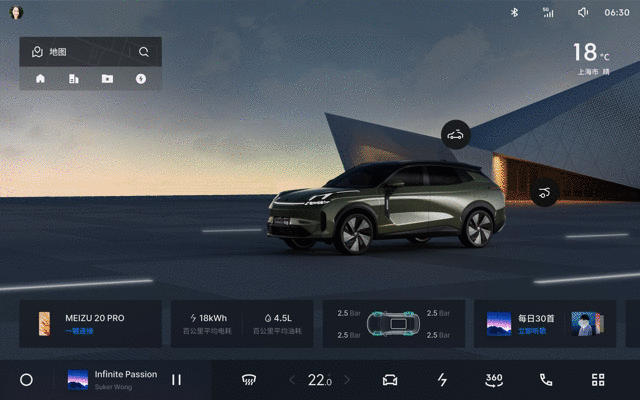 I had never seen such smooth transition animations in any car before: from the Lynk & Co 08 main interface car model to the navigation interface; from navigation to settings; switching between different levels of settings is achieved by rendering distance, car model size changes, providing you with a seamless “one-shot” experience.
I had never seen such smooth transition animations in any car before: from the Lynk & Co 08 main interface car model to the navigation interface; from navigation to settings; switching between different levels of settings is achieved by rendering distance, car model size changes, providing you with a seamless “one-shot” experience.
What is “Mobile Domain”?
At the launch event, Shen Zi Yu introduced the concept of “mobile domain”.
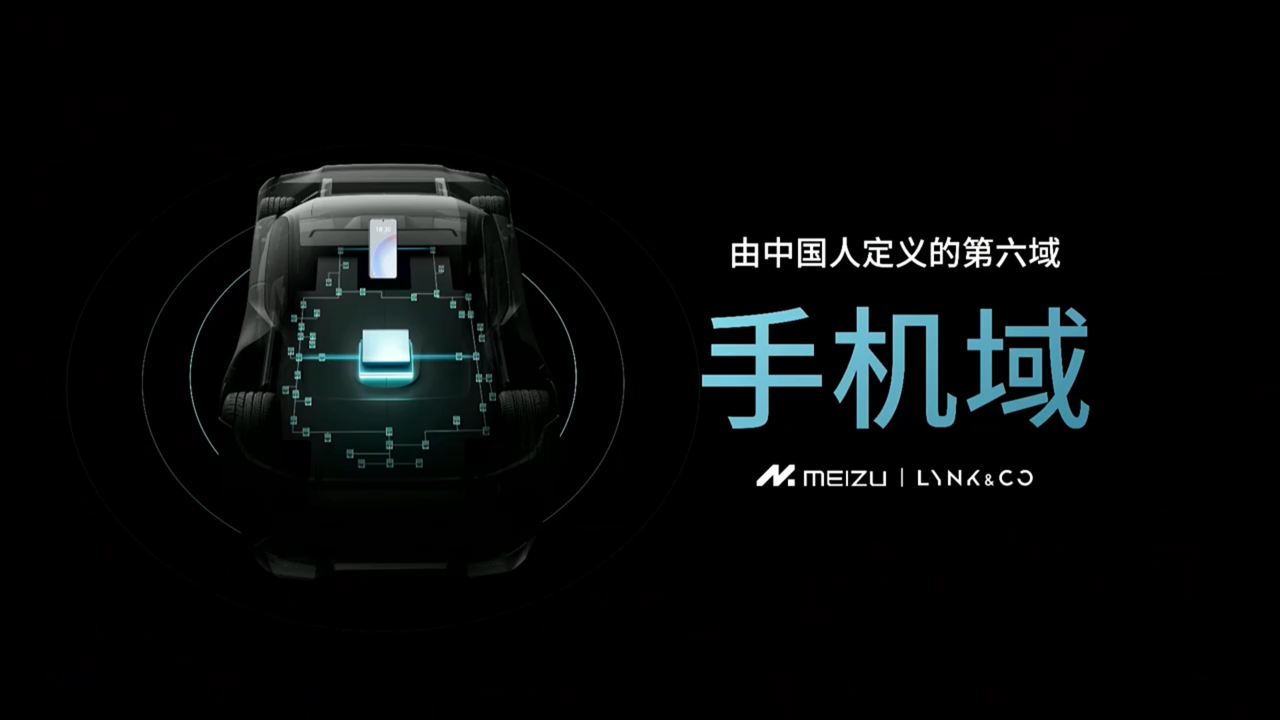
The traditional 5 domains include power domain, chassis domain, cabin domain, autonomous driving domain, and body domain, each of which is a collection of electronic and electrical architectures controlling major functional modules in a car. So, what can the so-called “mobile domain” achieve?
The answer is: before connecting to the car end, the phone preprocesses the computation and rendering of the applications and directly maps them to the car system.
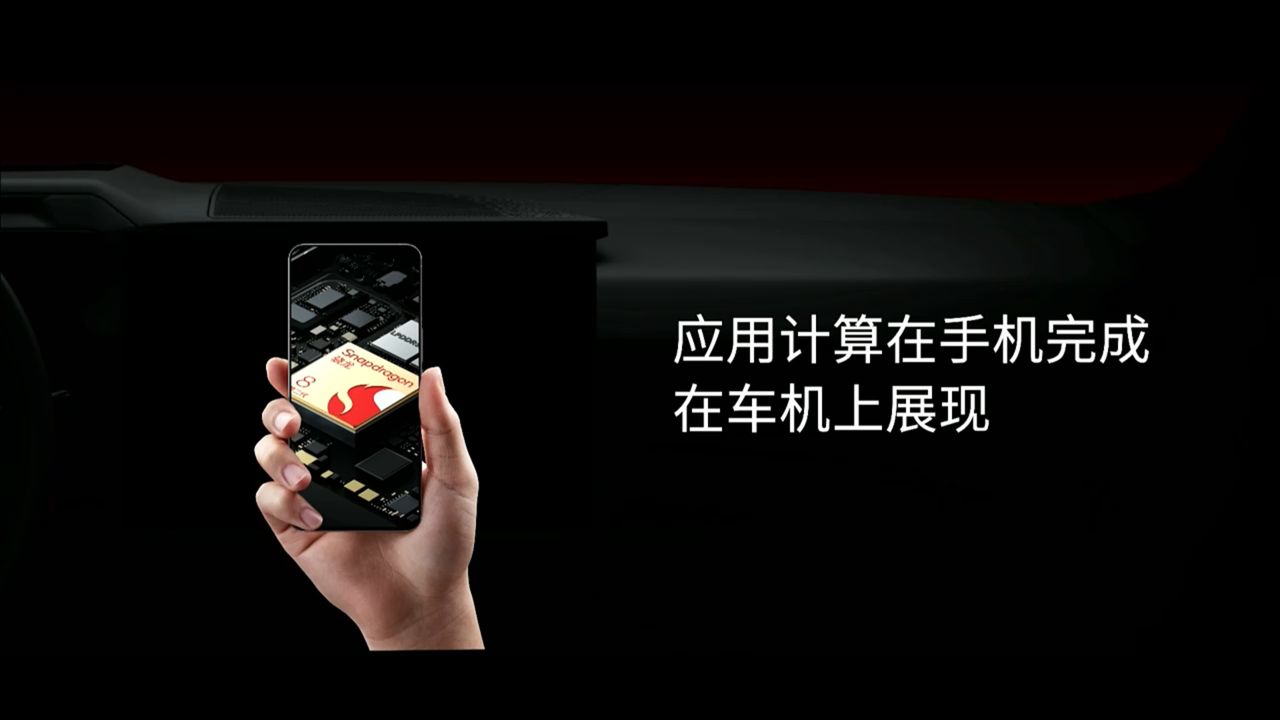
As most consumers replace their mobile phones more frequently and conveniently than the car’s infotainment system chipset, this alleviates many consumers’ anxieties about their car’s “outdated hardware”. With the expansion of mobile ecosystem, millions of mobile applications can be directly connected to the car, eliminating the need for cumbersome customization and optimization on the car system side.
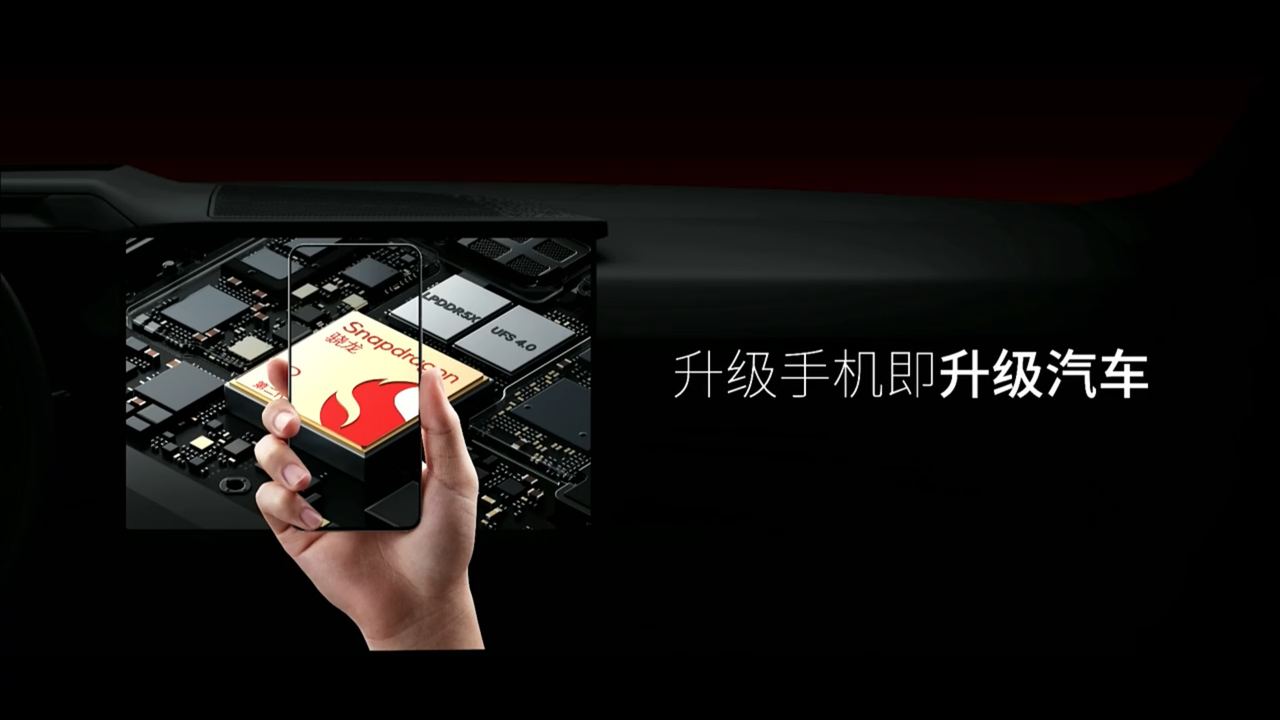
Another essential dimension of “boundless” expansion is “seamlessness”, which means how to achieve seamless connection between mobile phones and car systems?
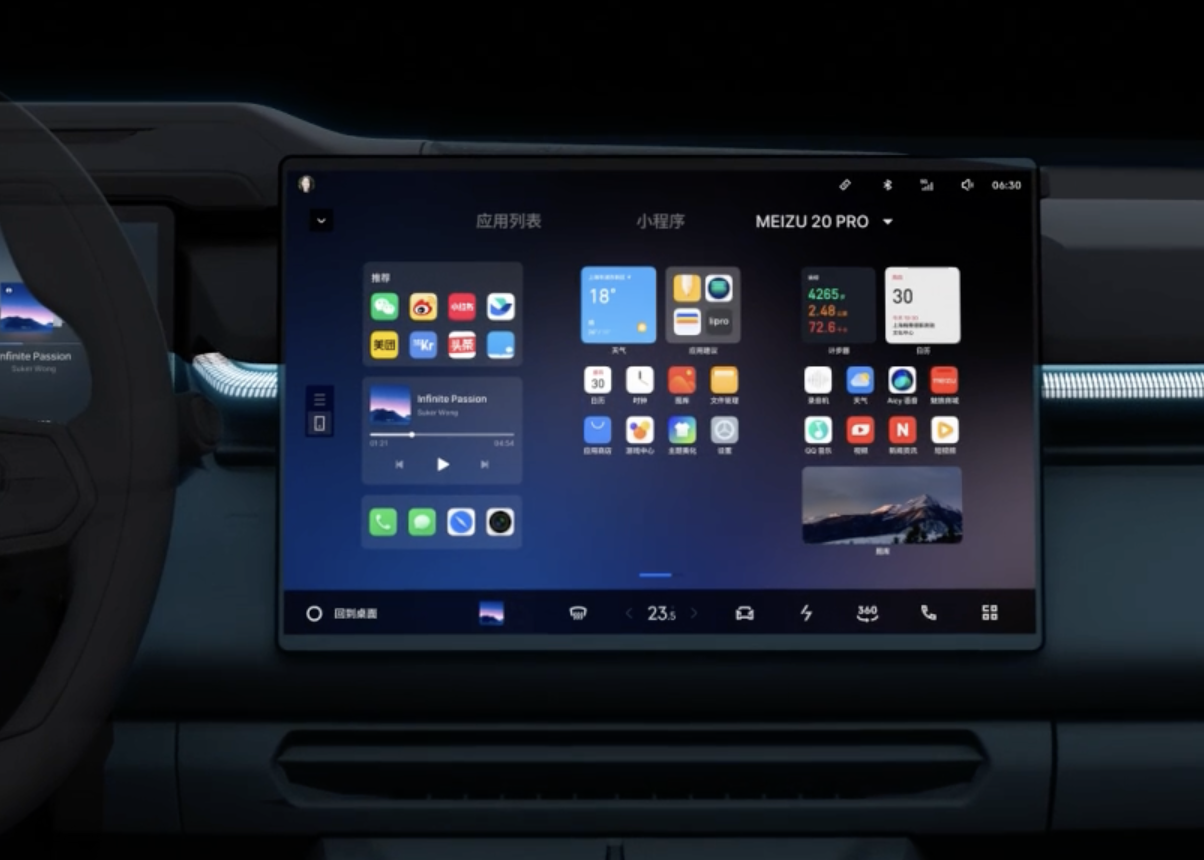
Taking Meizu 20 Pro and Lynk & Co 08 as an example. From getting in the car, Lynk & Co 08 can achieve a “seamless connection” with the mobile phone, without the need for searching, clicking, and waiting. What’s even more impressive is that Lynk & Co 08 has added an extremely ritualistic animation to the connection process with the help of linked ambient lighting.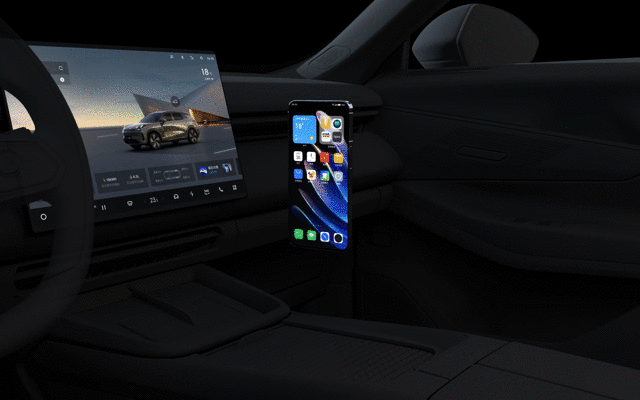
After considering how to better utilize mobile phones to assist in-car ecosystems, the Lynk & Co 08 equipped with Flyme Auto provides the following solutions: “Mini Window Display”, “Cross-Device Visibility and Voice Control”, “Application Handover”, and “Hardware Sharing”.
Under “Mini Window Display”, mobile apps will transfer to the Lynk & Co 08’s in-car interface. To avoid obstructing core information display and reading, the transferred apps are independently presented as floating mini windows on the left side.
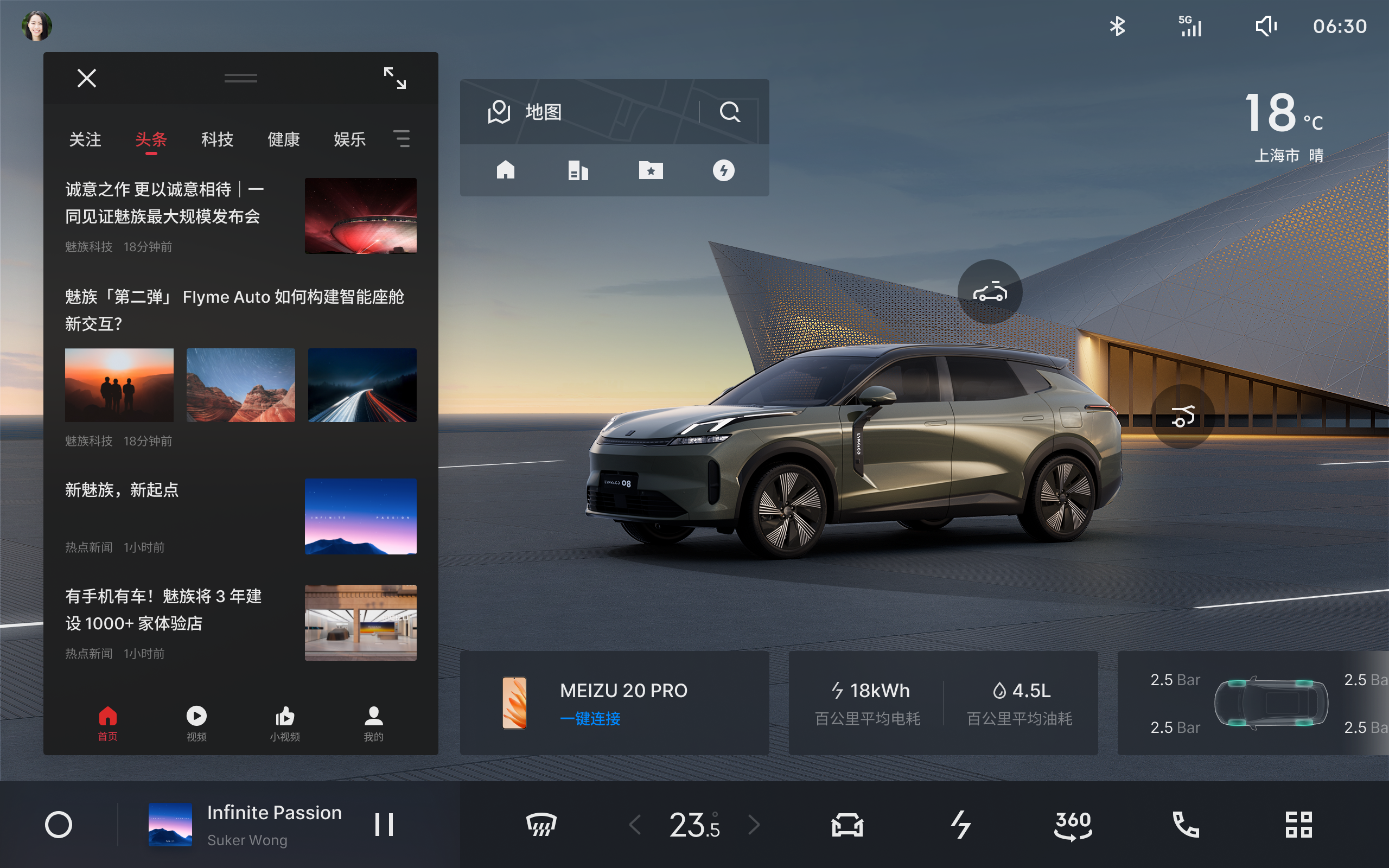
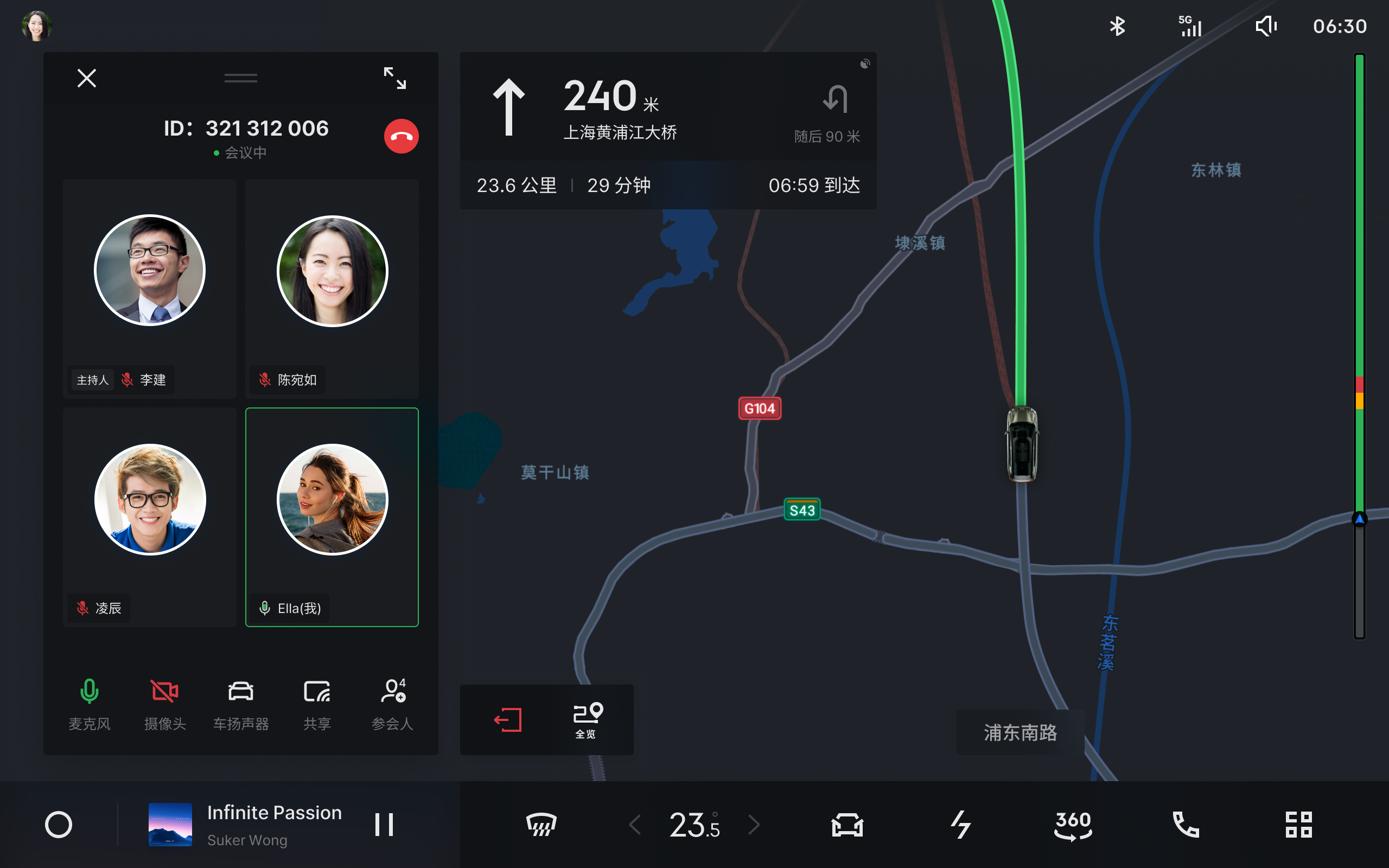
Voice assistant Aicy is not limited to supporting in-car apps; with the “Cross-Device Visibility and Voice Control” feature, mini windows transferred from the mobile side can also be voice-controlled on the Lynk & Co 08. Whether it’s the native ecosystem of the Flyme Auto-equipped Lynk & Co 08 or the mobile-expanded ecosystem, the voice experience is consistently strong, with no gaps in user experience.
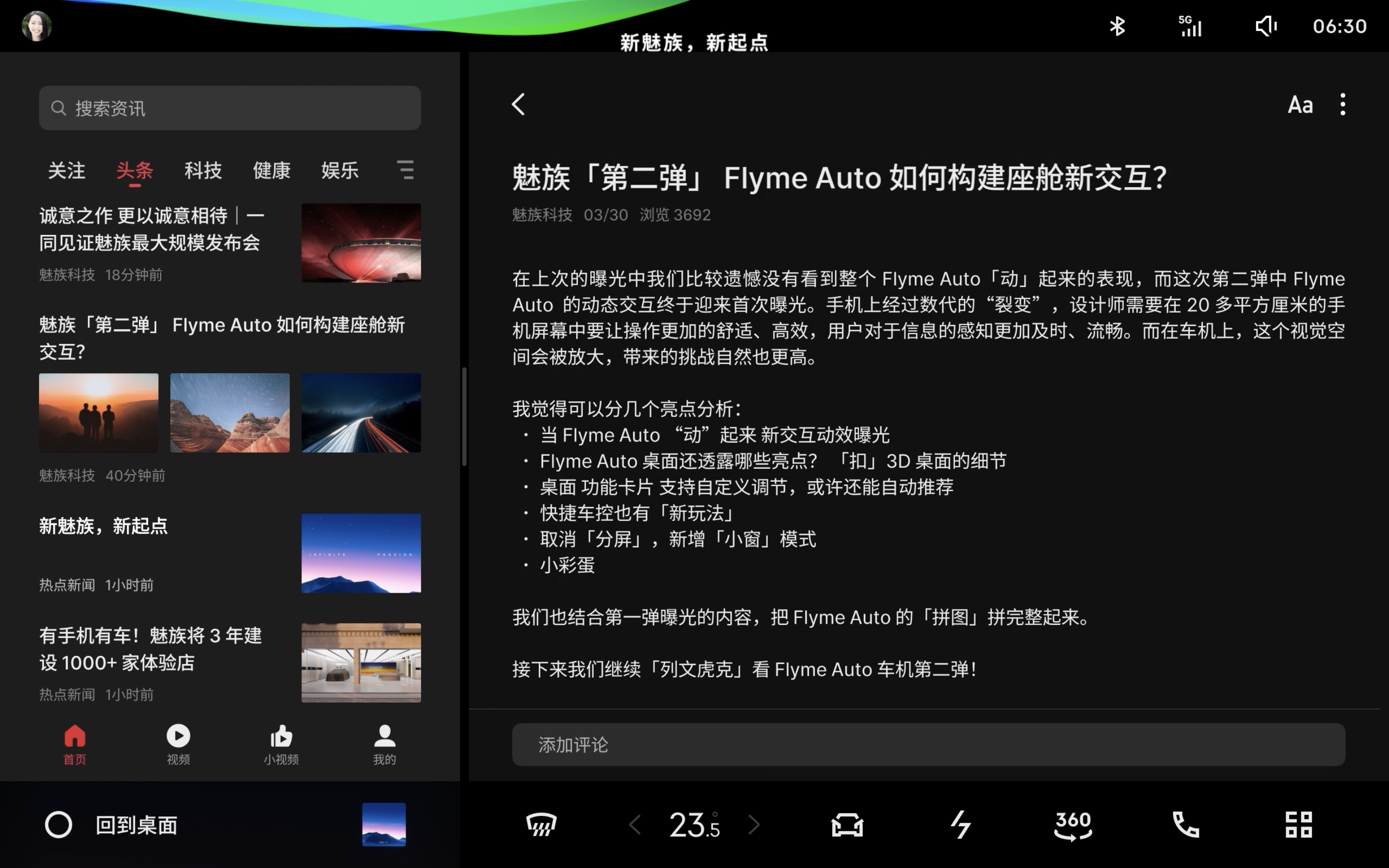
Under “Application Handover”, music and navigation information playing on the mobile side will automatically transfer to the vehicle system upon entering the car. Playing music and navigating seamlessly switches from mobile to in-car display. “Boundary-free” and “unnoticeable” remain the core principles in connecting mobile and in-car ecosystems.
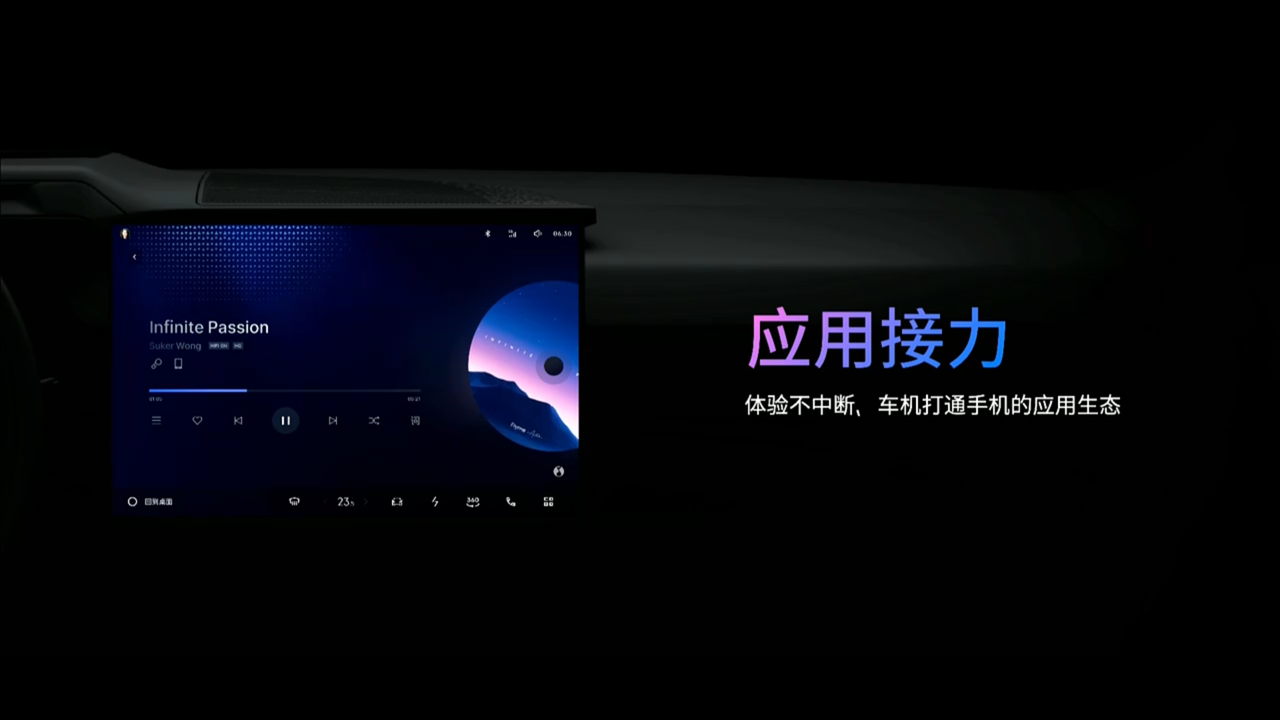
Even more remarkable is the collaboration between Lynk & Co 08 and Meizu, which not only integrates the software boundaries with mobile phones but also shares hardware with the in-car system. At the launch event, we saw three scenarios: mobile phone accessing the car’s cabin camera for floating window meetings, in-car gaming using the mobile phone as a controller, and mobile phones directly serving as microphones during karaoke. We look forward to experiencing these features on the Lynk & Co 08 soon.The CCC 3.0 UWB smartphone key made its debut on the Lynk & Co 08. In addition, Flyme Auto firmware upgrades can be downloaded to the phone, creating dual redundancy with the phone, preventing update failures in extreme cases.
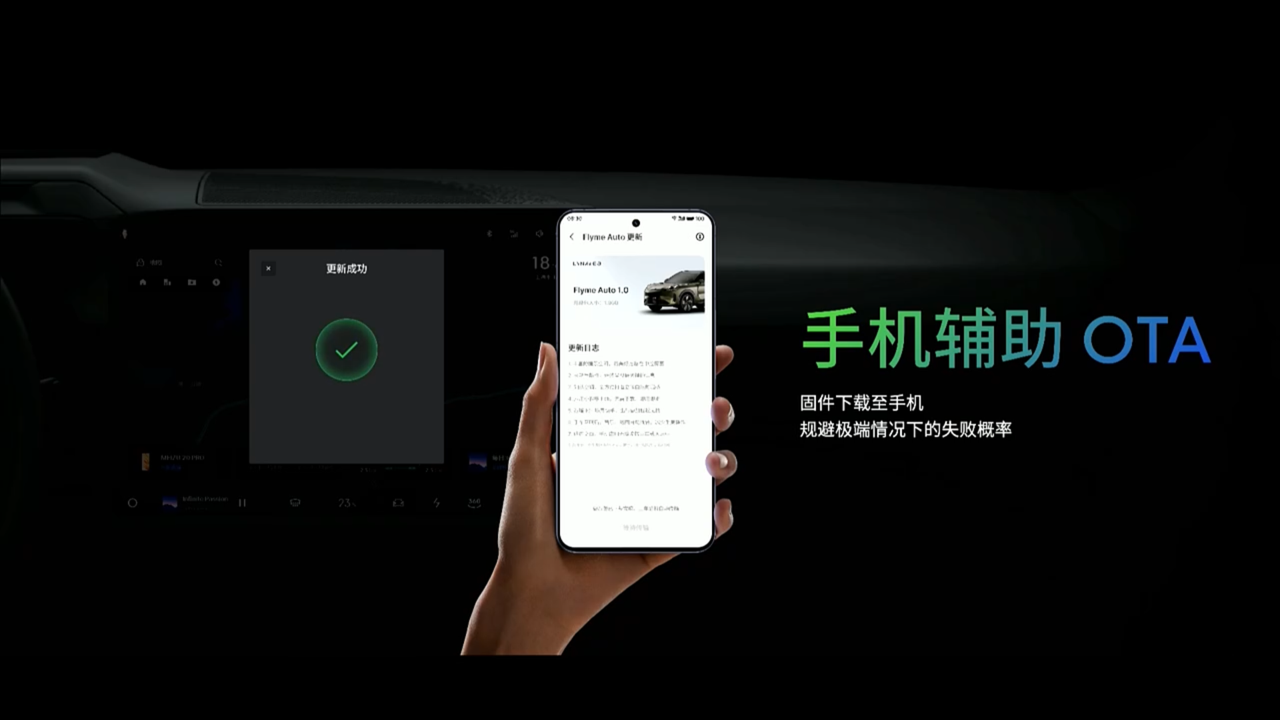
What we can observe is that, with the integration of car and smartphone, the Lynk & Co 08 cabin’s level of intelligence and convenience has increased by an order of magnitude. The user experience is no longer disjointed from pre-boarding to post-boarding, and there are no obvious boundaries between in-car and out-of-car scenarios.
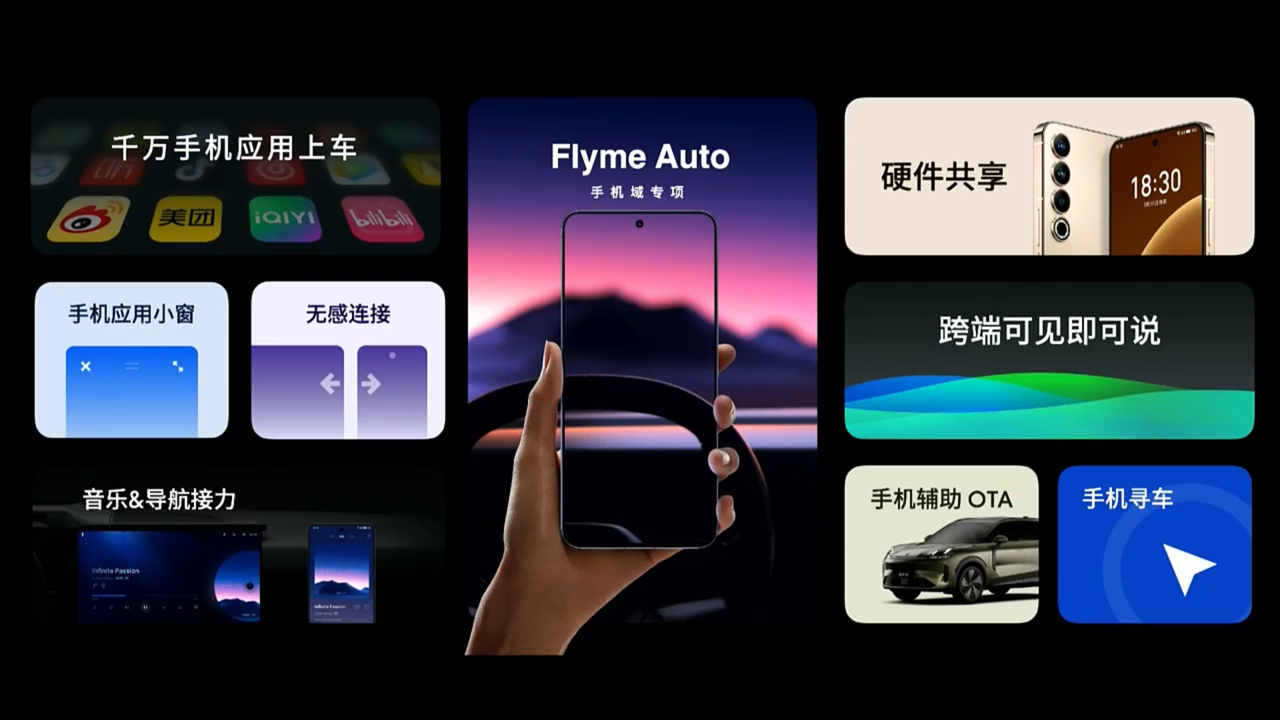
On infotainment systems of smart cars without smartphone integration, I have become accustomed to switching from the music app on my phone to the one on the car, re-entering my destination in the car’s navigation system, and waiting for OTA updates to push car-specific apps.
“Automakers without smartphone software empowerment will gradually lag behind,” appeared on a screen at the launch event.
However, I would also like to say: “Without well-designed cabins from automakers, simply relying on smartphone software empowerment is of no avail.”
From the collaboration between Lynk & Co 08 and Flyme Auto, we can see that, whether it is the in-depth cooperation on UI, color, and theme design, or the combination of the Lynk & Co 08’s ambient lighting, sound and Flyme Auto’s features, both parties bring their strengths, making each of them indispensable.
Lastly, I noticed a detail: on April 2, at the Meizu Wuhan Chu River and Han Street flagship store, a display car was prominently exhibited.
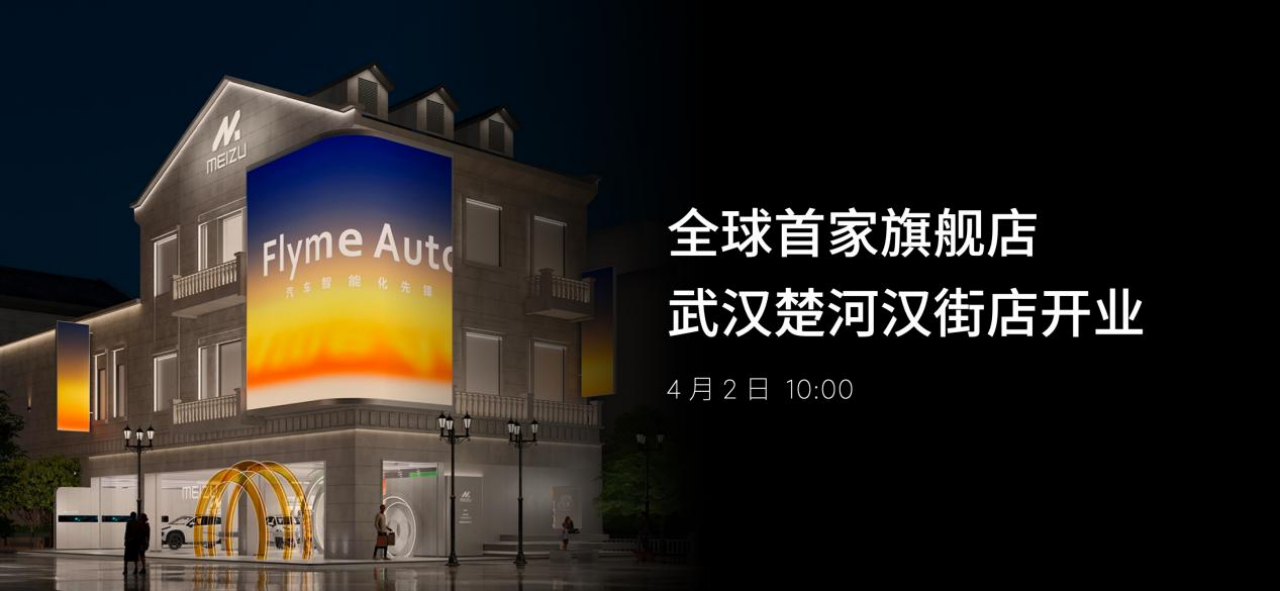
Meizu also announced a joint launch of the Meizu 20 series with “Lynk & Co Select.” This implies that Lynk & Co and Meizu are likely to collaborate more in distribution channels, with Lynk & Co entering Meizu stores and Meizu entering Lynk & Co stores.## Geely’s Ecosystem
In recent years, Geely has been strategically expanding and discretely investing in various industries. At this press conference, I was astonished more than once to see these previously inexplicable investments and collaborations bear fruit in this way.
For example, Meizu collaborated with Geely’s subsidiary “SpaceTime Odyssey” commercial satellite company to develop the customized satellite communication chip “Tianwen S1.” In the future, it will not only provide users with customized long-text bidirectional communication but also support voice transmission.
Another example is the car machine of the Lynk & Co 08, which uses the Antora 1000 Pro computing platform and the “Longying No.1” chip from Yikatong. Eric (Li Shufu) is also a co-founder of Yikatong.
The exciting Flyme Auto is also a representative of such “strategic alliances.” Meizu and Lynk & Co complement each other, both achieving significant advancements in their respective fields.
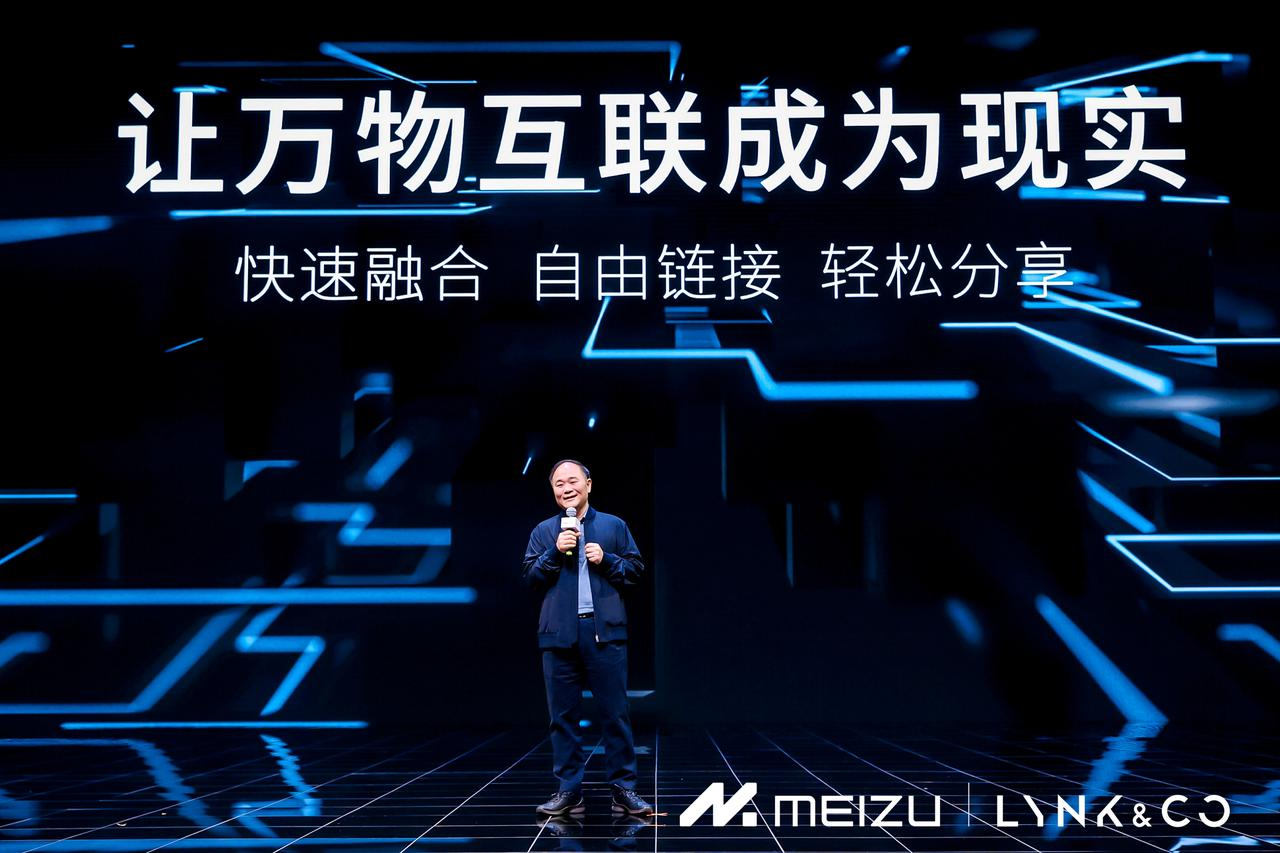
Five years ago, Li Shufu stated, “Future cars will be intelligent mobile space terminals, not simple transportation tools.” Therefore, when looking at Geely’s layout in recent years, it’s evident that the vast ecosystem that includes automakers, transportation companies, chip companies, autonomous driving companies, mobile enterprises, and commercial aerospace companies has a clear logic behind it.
The cooperation between Meizu and Lynk & Co serves as a model and exemplar, proving that the branches and leaves behind Geely’s ecosystem have already intertwined inadvertently.
This article is a translation by ChatGPT of a Chinese report from 42HOW. If you have any questions about it, please email bd@42how.com.
